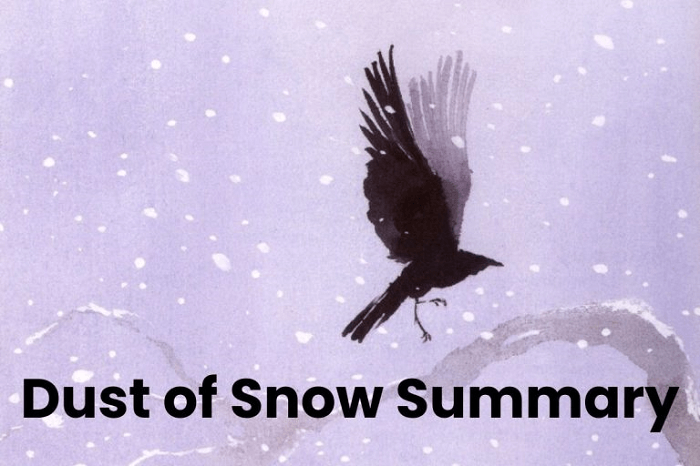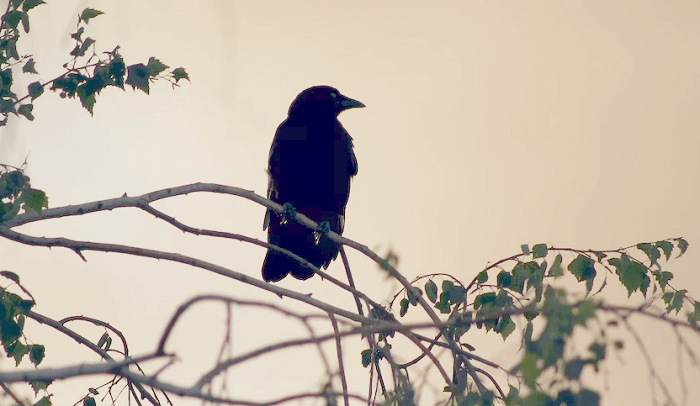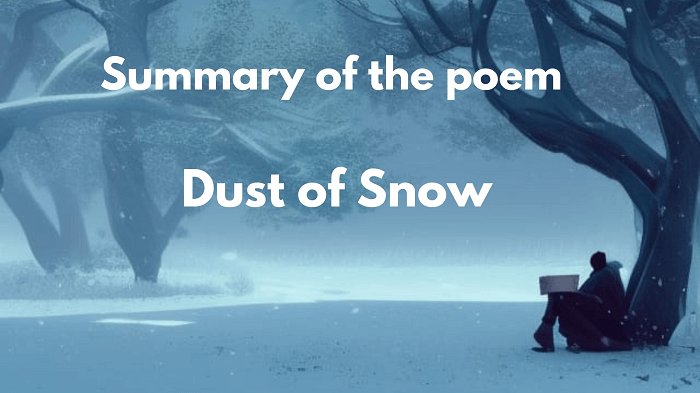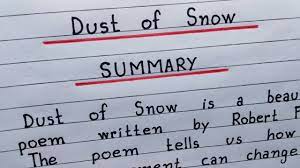Dust of Snow SummaryThe poem "Dust of Snow" was written by American poet and four-time Pulitzer Prize winner Robert Frost. The poem was initially released in 1923 in his poetry collection "New Hampshire." The poem is only eight lines long and has an easy-to-understand structure for each line, making it brief but effective. Frost's imagery and symbolism capture the transforming influence of nature on the human spirit. The poem describes a dull moment when a crow brushes snow from a hemlock tree. This unexpected mood change prompts the speaker to feel renewed and atonement. The poem shows evidence of Frost's ability to express intricate feelings and themes through seemingly unimportant circumstances. 
The Poem's Context and ToneThe poem's speaker is out for a walk in the woods in a wintery landscape. The snow on the trees and the ground produces an atmosphere of calm and serenity. The poem's speaker describes himself as being "waylaid" by the winter weather and feeling burdened by his thoughts, which sets the poem's tone as initially depressing and hopeless. However, this tone changes as the speaker sees a crow shaking snow off a hemlock tree. An upbeat tone is created by the visual of the "dust of snow" falling on the speaker and the change in his attitude. Ultimately, the poem expresses that redemption can be discovered in unexpected places, even in the most hopeless circumstances. The Speaker's Nature ExperienceNature is encountered by the speaker in "Dust of Snow" in the shape of a crow and a hemlock tree. A crow rattles snow from a hemlock tree while the speaker stains through the woods, feeling burdened and discouraged. Then, some snow falls on the speaker's head and shoulders. The speaker experiences a transformation due to this fast connection with nature, leaving him feeling revitalized. The experience highlights that even brief contact with nature can significantly impact our perspective and attitude. The Meaning of the Hemlock Tree and CrowThe crow and the hemlock tree are potent emblems in "Dust of Snow." Although the crow is frequently connected to death and the dark, it represents hope and redemption in this poem. The speaker's burden or weight is symbolized by the crow shaking off the snow from the hemlock tree. The metaphor of falling snow, or "dust of snow," refers to a fleeting moment of happiness or insight that can alter one's perspective on life. The hemlock tree, on the other hand, represents tenacity and toughness. The tree is strong and resilient despite the weight of the snow pressing down on it. The tree represents the natural world and its resilience in adversity. The crow and the hemlock tree stand for the ability of nature to effect change, rejuvenation, and hope. 
The Power of Life's Small MomentsIn "Dust of Snow," Robert Frost emphasizes the importance of life's little victories. A seemingly insignificant event the "dust of snow" falling from the tree onto the speaker's head and shoulders changes the speaker's entire mood. The poem makes the case that even the simplest interactions with nature have the power to inspire feelings of regeneration and salvation. Similar to how small moments of happiness or clarity can significantly impact our emotions and outlook. The poem encourages us to cherish these insignificant occasions and be receptive to nature's transforming influence. It serves as a reminder that even in the most hopeless circumstances, there is always reason for optimism. The Changing Mood of the SpeakerIn "Dust of Snow," the speaker's attitude shifts from despair to optimism. The poem's speaker initially expresses his experience of being overwhelmed by his thoughts and the wintery surroundings. The speaker, however, surprisingly feels better when a crow scrapes snow off a hemlock tree, and a small portion falls on him. The speaker refers to the snow falling as a "dust of snow," a brief period of happiness or clarity that significantly impacts their attitude. The speaker has a sense of renewed vitality and hopefulness in place of sadness. The speaker's mood changes highlights that even brief contact with nature may significantly impact our mental state. The Redemption and Renewal ThemeIn "Dust of Snow," atonement and renewal are major themes. The speaker's head and shoulders being covered in the "dust of snow" is a pivotal moment that inspires feelings of regeneration and atonement. The snow symbolizes the burdens we carry in life, and the snowfall is a period of catharsis or release. The interaction with nature sparks the speaker's emotional metamorphosis. The poem shows room for rebirth and restoration, even in dire circumstances. This subject is relevant to our lives because it serves as a gentle reminder that even the tiniest experiences with nature can have a profoundly positive impact on our emotional health. We can find moments of rebirth and hope in unexpected places. Relevance of the Poem in the Modern WorldDue to its emphasis on the transformational power of nature and the significance of finding hope and salvation in little moments, the poem "Dust of Snow" is still relevant today. It is simple to ignore the fleeting moments of happiness and clarity that can significantly impact our mental well-being in our fast-paced and frequently stressful life. The poem serves as a reminder that even in times of upheaval and ambiguity, we can experience moments of renewal in the natural world around us. The poem also reminds us to appreciate and be more aware of the beauty of nature and the little joys it can bring. The poem conveys a message of hope and optimism that is just as applicable today as it was when it was first penned in a world that may frequently feel overwhelming. The Importance of "Dust of Snow" in LiteratureIn conclusion, Robert Frost's "Dust of Snow" is a brief but potent poem that has become a classic American literature classic. The poem is a timeless work of Literature because its themes of redemption, rebirth, and the transforming force of nature still speak to readers today. The poem is a well-liked choice for classroom study and private thought because of its straightforward and approachable language and universal message. Even in the depths of the darkest times, there is hope to be discovered in unexpected places, as "Dust of Snow" serves as a reminder. The speaker in the poem can have a moment of catharsis and release via the brief interaction with nature, reminding us of the value of being present and conscious in our daily lives. In general, "Dust of Snow" is a tribute to the poetry's enduring strength and capacity to captivate readers across time and generations. 
Analysis of the Language and Structure of the PoemThe language and organization of "Dust of Snow" are straightforward and understandable while significantly impacting. The poem has two stanzas, each with two lines, and uses the straightforward AABB rhyme scheme. This format highlights the poem's brevity and concision while also highlighting the significance of the brief period that acts as the poem's focal point. The poem's basic language is filled with short, uncomplicated lines that express the speaker's emotions and attitude. The poem's stark and straightforward language is influenced by the fact that the terms "hemlock tree," "crow," and "snow" are all monosyllabic. Frost skilfully uses imagery, clearly showing the snow falling and the speaker's response. The word "dust" describes the snow because it emphasizes how little and inconsequential it is while evoking a sense of delicate beauty. The poem's language and organization also help convey its main ideas and themes. The poem's shortness and simplicity highlight that even the most insignificant events can significantly influence. The use of imagery and figurative language underlines the beauty and majesty of nature, while the clear language emphasizes the significance of being present and conscious in our daily lives. Overall, "Dust of Snow's language and structure combine to produce a memorable and powerful poem that still impacts readers today. Robert Frost's Other Works ComparisonRobert Frost composed many poems over his lengthy and successful career as a poet, "Dust of Snow" being only one. Frost was renowned for his talent for capturing daily life's essence and expressing complicated emotions in straightforward, understandable language. Even though "Dust of Snow" is a brief and simple poem, it has much in common with Frost's other works. The poem "The Road Not Taken," one of Frost's best-known works, likewise addresses choosing decisions in life and their implications. Both poems emphasize the need to be present and conscious in one's daily life, and "Dust of Snow" and "The Road Not Taken" both use straightforward language and imagery to convey their messages. Winter imagery evokes thought and introspection in "Stopping by Woods on a Snowy Evening," another well-known poem by Frost. This poem, like "Dust of Snow," emphasizes the transformational influence of nature and the necessity of taking the time to enjoy the beauty of our surroundings. While each of Frost's poems is distinctive, many of his piece's deal with the same issues and convey the same ideas. In "Dust of Snow," Frost demonstrates his talent for using straightforward language and images to convey complicated emotions, a trait that permeates most of his body of work. Nature's Importance in Robert Frost's PoetryRobert Frost's poems frequently featured nature, and "Dust of Snow" is no exception. Frost's poetry frequently explores complicated emotions and issues in natural settings and imagery, and his talent for evoking the majesty and force of nature is a defining characteristic of his writing. In "Dust of Snow," the speaker's experience with the crow and the hemlock tree emphasizes the transformational power of nature. The speaker's mood is improved by this brief but meaningful moment in nature, symbolized by the snow falling as a moment of redemption and renewal. In his poetry, Frost frequently explores nature as a source of rejuvenation and rebirth, as evident in pieces like "Birches" and "After Apple-Picking." The interaction between people and the natural world is a recurring theme in Frost's poetry. In "Dust of Snow," the speaker's interaction with the crow and the hemlock tree reveals a relationship between human emotion and the natural world. Poems that look at the intricate link between people and nature, such as "Mending Wall" and "The Tuft of Flowers," further explore this topic. Overall, nature plays a big part in Robert Frost's poetry and is frequently used to explore deep feelings and topics. His poetry frequently explores the transformational impact of natural moments and the beauty and majesty of the natural world. Universal Message and Themes of the PoemDespite its brevity, "Dust of Snow" touches on timeless issues and morals that still speak to readers today. One of the poem's major themes is that even the most insignificant events in life can have a significant impact. The speaker's interaction with the crow and the hemlock tree teaches how important it is to remain open to the possibilities of the world around us and how even seemingly unimportant or unexpected events can have profound value. The poem also addresses nature's transformational influence. The speaker experiences a moment of repentance and renewal as the snow falls, underscoring how healing nature is. It is a recurring subject in Literature that people can find healing and renewal in nature. This message is especially important today because people are isolated from nature. 
The poem also stresses the value of living in the present and practicing mindfulness. The poem's shortness and simplicity highlight the notion that we should always be aware of the world around us and be receptive to the unanticipated events that may significantly impact our lives. The overall message of "Dust of Snow" is one of regeneration and hope, highlighting the need to be present and conscious in our daily lives and the transformational power of nature. Role of Poetry in the Expression of FeelingsThe essence of poetry is its ability to communicate feelings and experiences. Reading poetry enables readers to engage with the work on a profound and emotional level because of its remarkable capacity to convey complicated feelings and experiences in a way that is both individual and universal. In the poem "Dust of Snow," the speaker's sense of redemption and regeneration is communicated in a way that is understandable to all readers through the poem's straightforward yet effective language. The falling snow and the images of the crow and the hemlock tree combine to produce a striking and moving scene that illustrates the transformational power of nature. The poem's brevity and simplicity also emphasize the value of economy in poetry. In just eight lines, Frost can express a nuanced emotional experience that connects with readers deeply. The poem is a potent and enduring work of poetry because of its enduring themes of optimism and renewal and its approachable language and imagery. Overall, poetry's ability to transmit complicated feelings and experiences in an individualized, universal, and enduring way is essential to the art form. Works like "Dust of Snow" exemplify how poetry may do this.
Next TopicFire and Ice Summary
|
 For Videos Join Our Youtube Channel: Join Now
For Videos Join Our Youtube Channel: Join Now
Feedback
- Send your Feedback to [email protected]
Help Others, Please Share









